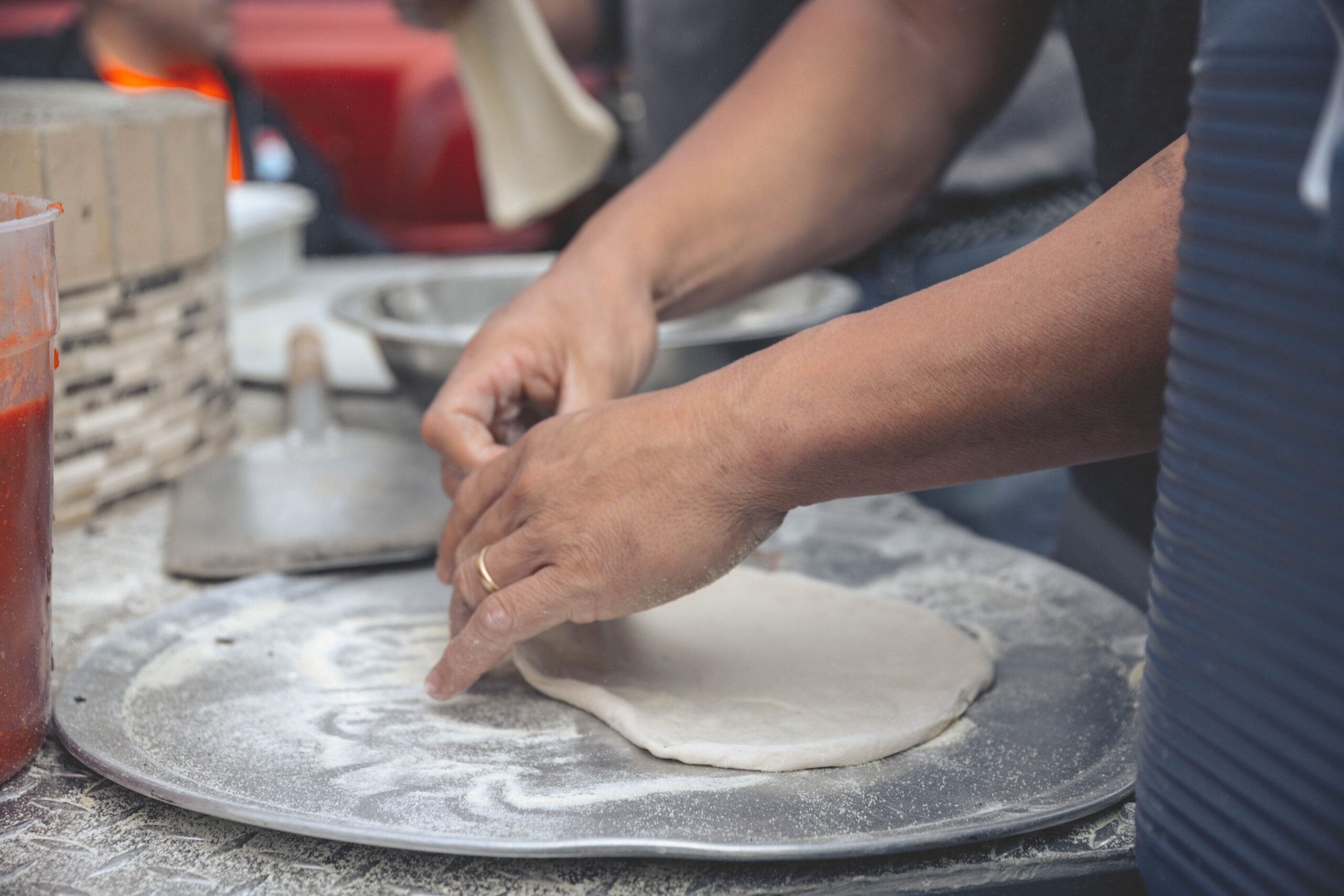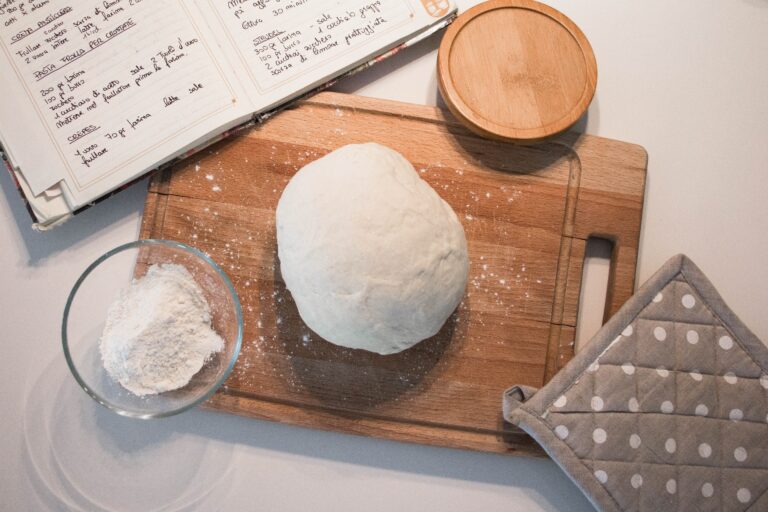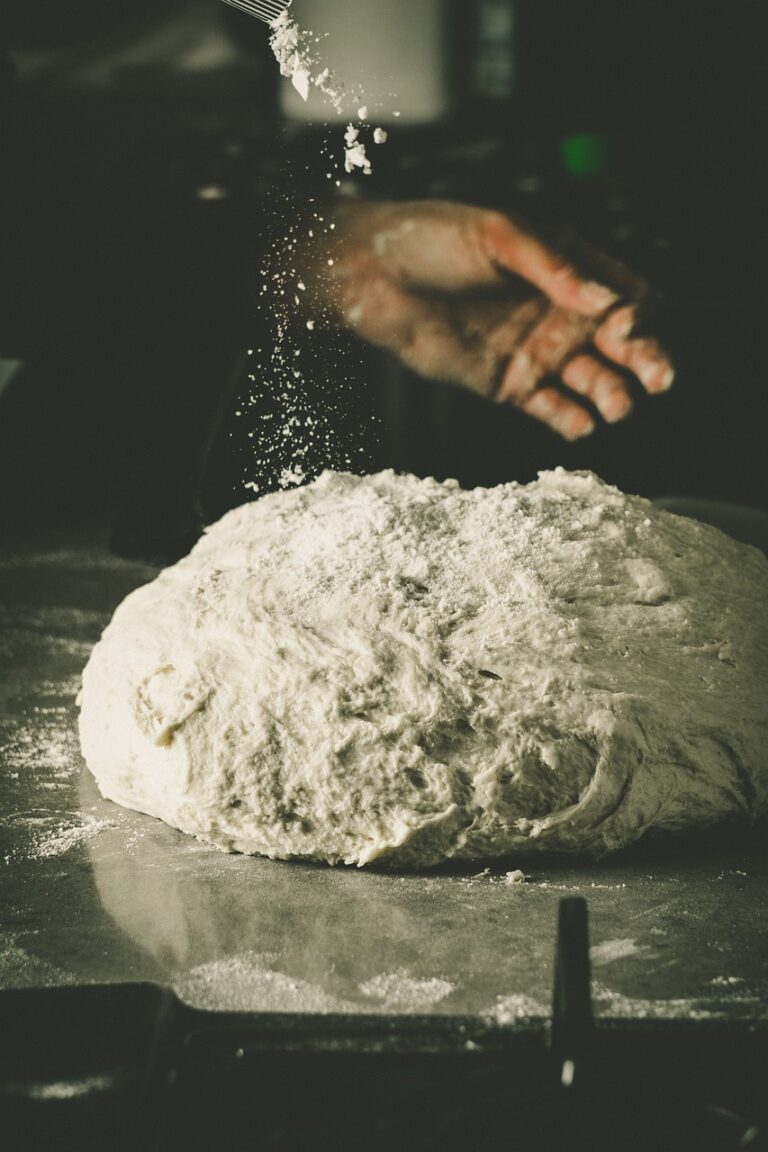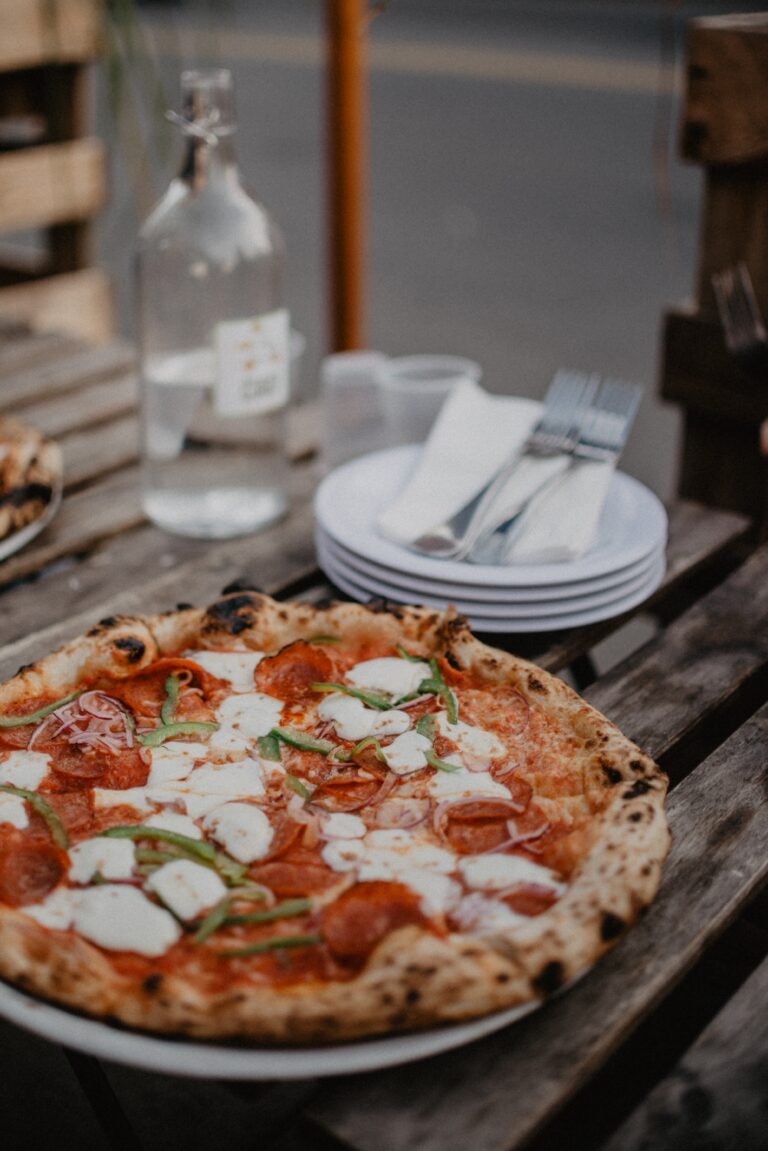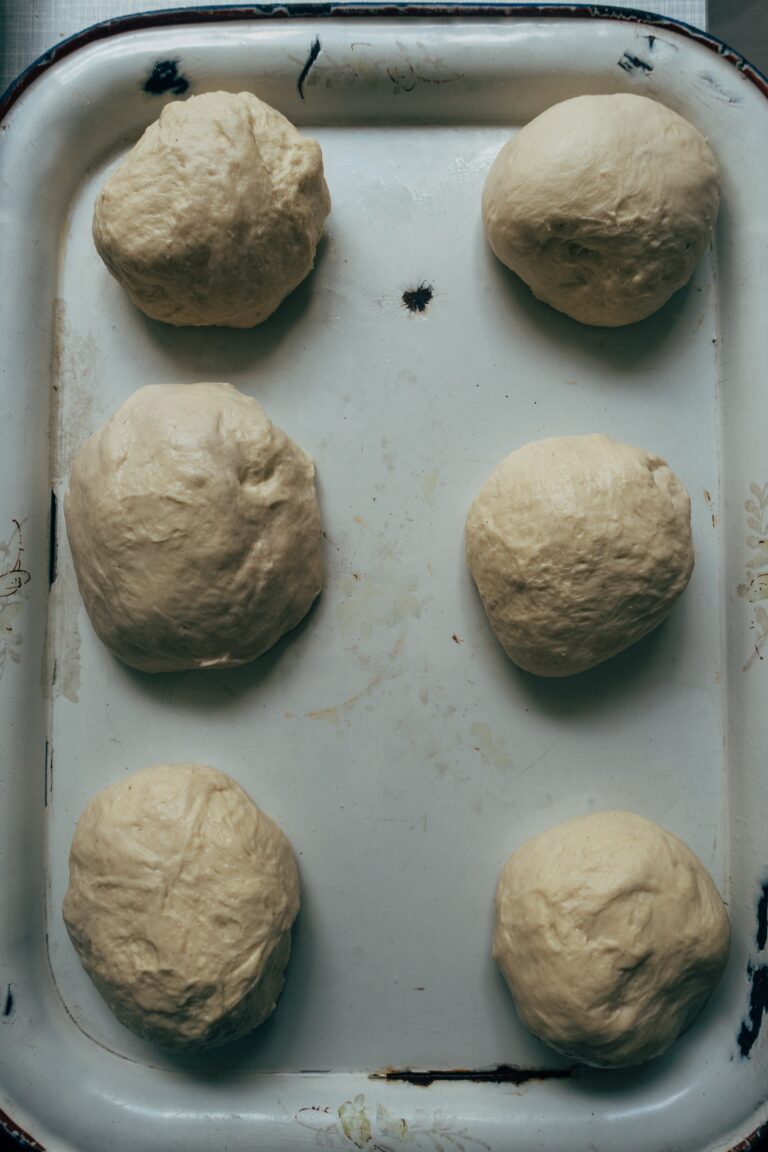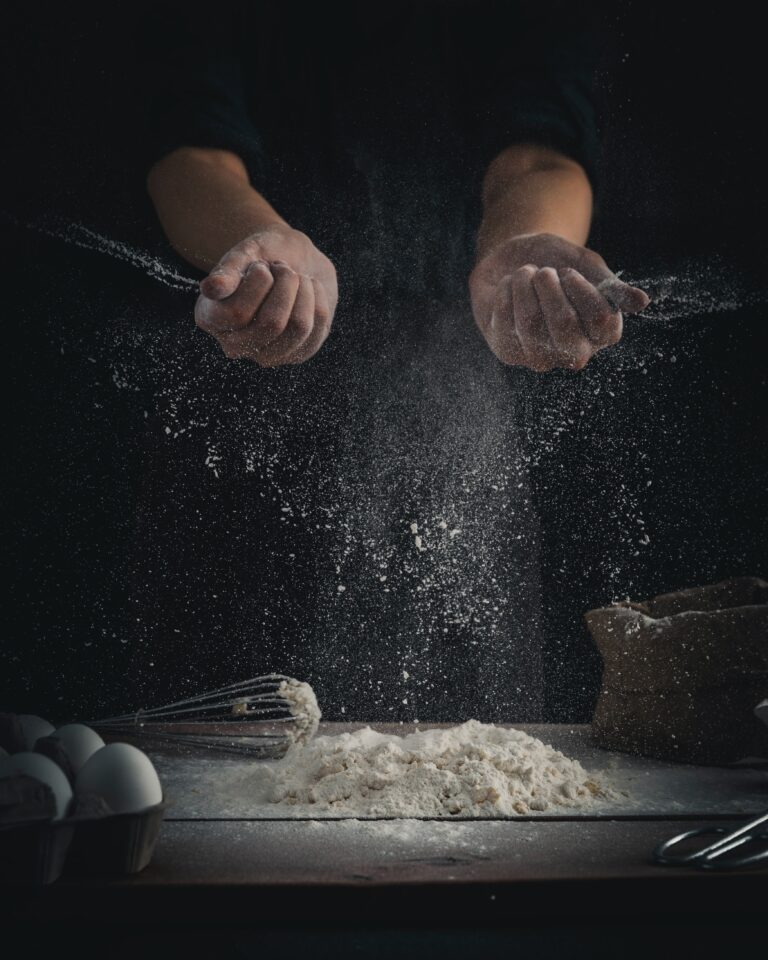Cornmeal Pizza Crust Recipe
Are you tired of the same old pizza crust? Look no further! This article will show you how to make a delicious cornmeal pizza crust that will take your taste buds on a culinary adventure.
You can create a unique and flavorful base for all your favorite toppings with simple ingredients and easy-to-follow instructions. Get ready to impress your friends and family with this innovative twist on traditional pizza crust. Let’s get started!
Ingredients for Cornmeal Pizza Crust
You’ll need just a few simple ingredients for your cornmeal pizza crust. This versatile crust is perfect for those seeking gluten-free pizza options or experimenting with different cornmeal crust variations.
To make this innovative and delicious crust, you’ll need 1 cup of fine yellow cornmeal, 1 cup of all-purpose flour (or gluten-free flour blend if desired), one tablespoon of sugar, one teaspoon of salt, two teaspoons of baking powder, two tablespoons of olive oil, and ¾ cup of warm water.
Mix the cornmeal, flour (or gluten-free alternative), sugar, salt, and baking powder in a mixing bowl. Mix well until all the dry ingredients are evenly combined. Then, add the olive oil and warm water to the mixture. Stir until you have a soft dough that holds together.
Once your dough is ready, transfer it onto a lightly floured surface and knead it for about one minute. This step will help develop the gluten in regular flour or create elasticity in gluten-free alternatives.
Now you’re ready to roll out your crust! Use a rolling pin to flatten the dough into your desired shape and thickness—whether round or square—it’s up to you! Remember to dust your surface with additional cornmeal or flour to prevent sticking.
And there you have it! Your homemade cornmeal pizza crust is now ready to be topped with all your favorite ingredients before baking it to perfection. Enjoy this innovative twist on traditional pizza crusts while exploring various flavors and textures with different toppings.
Mixing the Cornmeal Pizza Dough
Combine the dry ingredients in a mixing bowl to ensure a well-blended dough. This is an essential step in making a delicious cornmeal pizza crust.
Here are some mixing techniques and troubleshooting tips to help you along the way:
-
Gentle Folding: Use a spatula or wooden spoon to fold the dry ingredients into the wet ingredients gently. Avoid over-mixing, as this can result in a challenging and dense crust.
-
Slow Incorporation: Gradually add the wet ingredients to the dry mixture while stirring constantly. This will help prevent lumps and ensure an even distribution of all the ingredients.
-
Kneading: Once all the ingredients are combined, transfer the dough onto a lightly floured surface and knead it for about 5 minutes. Kneading helps develop gluten, giving your crust its desired texture.
-
Resting Time: After kneading, let the dough rest for at least 30 minutes. This allows the gluten to relax and makes it easier to shape your pizza crust without shrinking back.
If you encounter any issues during mixing, such as a dry or sticky dough, don’t panic! Adjust with small amounts of flour or water until you achieve consistency.
Rolling and Shaping the Cornmeal Pizza Crust
When it comes to rolling and shaping your cornmeal pizza crust, you need to keep a few key points in mind.
First, proper crust thickness is crucial for a balanced texture and taste. You’ll also want to avoid uneven edges, which can lead to an inconsistent baking process.
Proper Crust Thickness
Roll out the dough to your desired thickness for a crisp crust. To achieve the perfect crust thickness consistency, follow these steps:
-
Use a rolling pin: Start in the center of the dough and roll outward in all directions. Apply even pressure to create an evenly thick crust.
-
Measure with your fingers: If you prefer a specific thickness, use your fingers as a guide while rolling. Press down lightly to ensure uniformity.
-
Check for transparency: Hold the rolled-out dough against a light source or window. You’ve achieved the desired thinness if you can see through it slightly.
Remember, experimenting with different thicknesses is part of the fun! Whether you like it thin and delicate or thicker with some chew, finding your personal preference will make each bite more satisfying.
So don’t be afraid to get creative and enjoy the process of making your cornmeal pizza crust!
Avoiding Uneven Edges
If your dough is not rolled out evenly, you may have uneven edges on your homemade pizza. To prevent this, you can try a few tips and tricks.
First, lightly flour your work surface before rolling out the dough. This will help prevent it from sticking and allow for easier manipulation. A rolling pin with even pressure will help ensure the dough is rolled out evenly. As you roll, periodically check the thickness of the dough to avoid any areas being too thin or too thick. Finally, when transferring the rolled-out dough onto your baking sheet or pizza stone, be gentle to maintain its shape and prevent any further stretching or tearing.
Following these steps, you’ll achieve a perfectly shaped crust with no uneven edges.
In addition to preventing the dough from sticking and achieving an even crust, another critical aspect of making homemade pizza is earning a crispy crust. To do this, preheating your oven at a high temperature (around 475-500°F) is crucial for creating that desired crunchiness.
Another tip is to bake your pizza on a preheated baking stone or steel if possible; these materials provide better heat distribution, resulting in a crispier crust than a regular baking sheet. Lastly, consider par-baking your crust before adding toppings – this involves partially baking the crust without any toppings for about 5 minutes before adding sauce and other ingredients – which helps create an extra layer of crispness while preventing sogginess in the middle.
Techniques for Shaping
Now that you’ve learned how to avoid uneven edges on your cornmeal pizza crust, let’s dive into some shaping techniques to help you achieve a perfect, professional-looking crust every time.
-
Stretch and toss: Start by gently stretching the dough with your hands, allowing it to pull itself naturally. Then, lift the dough with both hands and throw it lightly in the air while rotating it between your palms. This technique creates a thin and even crust.
-
Rolling pin method: If you prefer a thicker crust, use a rolling pin to shape the dough evenly. Start from the center and move outward until you reach your desired thickness.
-
Edge control: To achieve an appealing thick edge or ‘cornicione,’ use your fingertips to push the outer rim of the dough towards the center while leaving enough space for toppings in the middle.
Preparing the Cornmeal Pizza Crust for Baking
When preparing the perfect cornmeal pizza crust, remember a few key points.
First, cooking time and temperature are crucial for achieving that crispy yet tender texture.
Second, deciding whether to add your toppings before or after baking can make a big difference in your pizza’s overall flavor and presentation.
And finally, if you’re feeling adventurous, don’t be afraid to explore alternative crust options like cauliflower or zucchini for a healthier twist on this classic dish.
Cooking Time and Temperature
The suggested cooking time for the cornmeal pizza crust is 15-20 minutes at 425°F. This temperature ensures a crispy and golden crust that perfectly complements your toppings.
The cornmeal-infused dough will rise slightly as the oven preheats, creating a light and airy base for your innovative pizza creations. The high heat of 425°F helps to develop a beautifully browned exterior while keeping the interior tender and moist.
This cooking time and temperature combination allows for even baking throughout, ensuring that every bite is bursting with flavor. Whether topping your pizza with classic ingredients or experimenting with bold flavors, this cooking time and temperature will give you the ideal balance of crispness and chewiness in your cornmeal pizza crust.
Adding Toppings Before Baking
You’ll want to add your favorite toppings generously before sliding them into the oven to achieve the perfect balance of flavors. This step is crucial in creating a mouthwatering cornmeal pizza crust that will leave you craving more. Prepare to unleash your creativity as you prepare your toppings for this innovative twist on traditional pizza.
Here are four exciting ideas to inspire your pre-baking preparation:
-
Roasted vegetables: Elevate your pizza by adding a colorful array of roasted veggies like bell peppers, zucchini, and onions. Their caramelized sweetness will complement the hearty crust beautifully.
-
Gourmet cheeses: Experiment with different artisanal cheeses, such as creamy goat or tangy blue cheese. Their unique flavors will take your pizza to the next level.
-
Fresh herbs: Don’t forget to sprinkle fresh basil, oregano, or thyme on your creation. These aromatic herbs will add depth and freshness to every bite.
-
Spicy kick: If you’re adventurous, why not add sliced jalapeños or red pepper flakes? The heat will provide an exciting contrast against the subtle corn flavor.
Let your imagination run wild with these topping ideas and create a genuinely innovative cornmeal pizza masterpiece!
Alternative Crust Options
Now that you know how to add toppings before baking your cornmeal pizza crust, let’s explore alternative crust options. Whether you’re looking for a gluten-free option or want to try something new, there are plenty of delicious alternatives to traditional pizza crust.
To help you navigate through the world of crust alternatives, here is a handy table showcasing four different options:
| Crust Alternative | Description |
|---|---|
| Cauliflower | This low-carb crust is crispy and flavorful and made from finely grated cauliflower mixed with eggs and cheese. |
| Zucchini | Grated zucchini combined with almond flour creates a light, moist crust that pairs well with fresh toppings. |
| Sweet Potato | Roasted sweet potatoes mashed with oats form a slightly sweet and hearty base for your pizza creations. |
| Quinoa | A protein-packed option, quinoa flour mixed with water creates a nutritious and chewy crust that holds up well under toppings. |
These alternatives offer unique textures and flavors while providing a sturdy base for all your favorite ingredients. So experiment with these crust options to elevate your pizza experience!
Baking and Topping the Cornmeal Pizza Crust
Once the cornmeal pizza crust is baked, it’s time to add your favorite toppings. This is where you can get creative and experiment with different baking techniques and flavor variations.
The cornmeal crust provides a unique twist to traditional pizza, adding a delicious crunch and nutty flavor that elevates the overall taste experience.
When it comes to baking the cornmeal crust, there are a few techniques you can try. Preheat your oven to a high temperature (around 475°F) for a crispier crust, and bake the pizza directly on a preheated baking stone or steel. This will help create that perfect golden brown color on the bottom while keeping the top ingredients nicely cooked.
You can bake the pizza on a regular baking sheet or use a cast-iron skillet if you prefer a softer crust. These methods will produce a slightly thicker and chewier crust that pairs well with heartier toppings like roasted vegetables or savory meats.
Now, let’s talk about flavor variations. You can play around with different combinations of toppings to suit your taste preferences. For an Italian-inspired twist, try using fresh mozzarella cheese, sliced tomatoes, and basil leaves, and drizzle some balsamic glaze over the top after baking. Or, if you’re feeling adventurous, experiment with international flavors like Thai chicken curry pizza or Mexican-inspired taco pizza.
Remember to have fun and let your imagination run wild when topping your cornmeal pizza crust. With endless possibilities at your fingertips, every bite will be an innovative explosion of flavors!
Serving and Enjoying the Cornmeal Pizza Crust
When it’s time to serve and enjoy your delicious creation, don’t forget to gather your friends and family for a delightful pizza night. The cornmeal pizza crust you’ve made is unique and incredibly versatile, allowing you to experiment with various flavors and toppings.
To enhance the dining experience, some serving suggestions and flavor variations will impress your guests.
For serving suggestions, consider creating a build-your-own pizza bar where everyone can customize their creations. Provide a variety of sauces like marinara, pesto, or even barbecue sauce. Offer an assortment of toppings, such as fresh vegetables like bell peppers, mushrooms, onions, and tomatoes. Don’t forget about the cheeses! Mozzarella, feta, or goat cheese are excellent options. And for those who love a little heat, sprinkle some red pepper flakes or drizzle hot sauce on top.
Let’s explore some flavor variations to take your cornmeal pizza crust to the next level. How about trying a Mediterranean-inspired pizza? Top the crust with hummus instead of sauce and add ingredients like grilled chicken or lamb, Kalamata olives, artichoke hearts, and crumbled feta cheese.
Or if you’re feeling adventurous, go for a Mexican twist by using salsa as the base sauce and adding ingredients like seasoned ground beef or shredded chicken along with black beans, corn kernels, and jalapenos for spice and finish it off with a dollop of sour cream.
Lastly, indulge in a dessert version of this unique crust by spreading Nutella on top instead of traditional sauce. Add sliced bananas or strawberries for freshness, and sprinkle some powdered sugar over it all.
With these serving suggestions and flavor variations in mind, you can create an unforgettable dining experience showcasing innovation and culinary expertise. So invite your loved ones over for an extraordinary pizza night they won’t soon forget!
